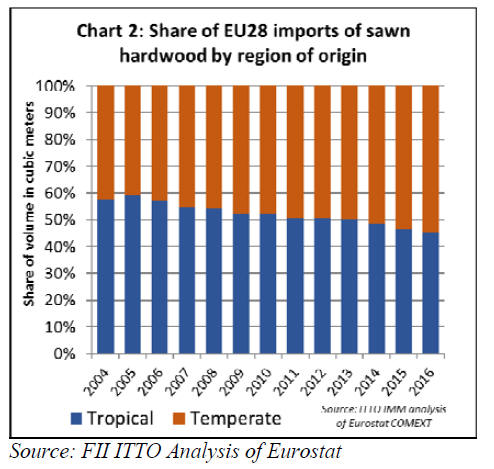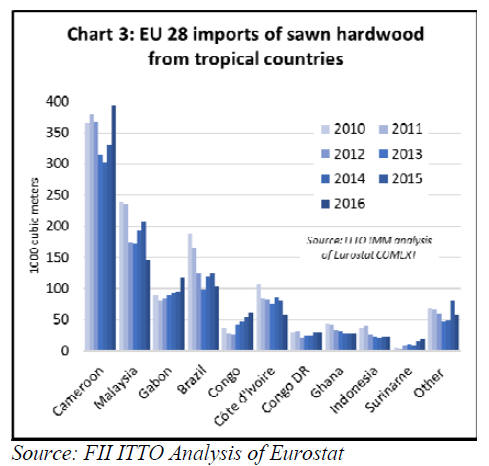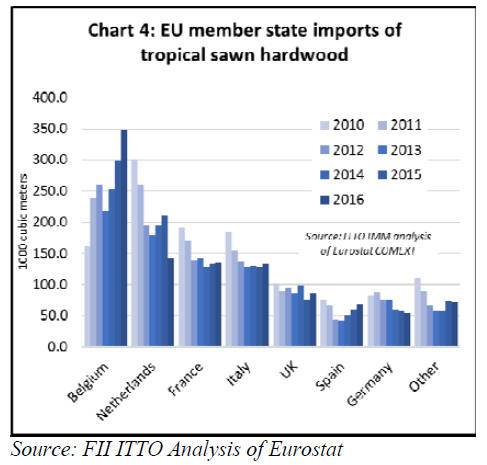|
Report from
Europe
EU tropical sawn hardwood imports remain static in
2016
In 2016, EU imports of tropical sawn hardwood were 1.04
million m3, unchanged from the previous year. The value
of EU imports increased by 2% to Euro775 million.
The average unit value of tropical sawn hardwood imports
into the EU in 2016 was Euro747 per cubic meter, up from
Euro730 per cubic meter the previous year.
The volume of EU imports of tropical sawn timber
remains stalled at historically very low levels. Import
volume in 2016 was 12% higher than the all-time low of
930,000 m3 recorded in 2013 but remains 40% below the
levels prevailing before the global financial (Chart 1).

The share of tropical in total EU sawn hardwood imports
declined from 46.5% in 2015 to 45.6% in 2016, continuing
a long term downward trend (Chart 2).
In 2016, EU imports of temperate sawn hardwood
increased 3% to 1.24 million m3. This was mainly due to a
13% increase in EU imports of sawn oak from Ukraine in
response to tighter controls on log exports from that
country and extreme weakness of the Ukrainian currency.

Rising dependence in EU on tropical sawnwood from
Cameroon
The most notable trend in the supply of tropical sawn
timber to the EU in 2016 was the rising dependence on
imports from Cameroon.
EU imports from Cameroon increased 19% to 395,000 m3
in 2016, growing particularly rapidly into Belgium but
with robust increases also into Italy, France, Spain, the UK
and the Netherlands (Chart 3).

There was a significant increase in EU imports of sawn
tropical wood from two other central African countries
during 2016. Imports were up 22% to 117,000 m3 from
Gabon and 13% to 62,000 m3 from the Congo Republic.
Imports from both countries mainly enter the EU by way
of Belgium.
However last year there was a particularly large increase
in UK imports from Congo Republic, from 6500 m3 in
2015 to 14000 m3 in 2016.
A combination of factors contributed to rising EU imports
from Cameroon, Gabon and Congo Republic during 2016
including the relative weakness of the euro against the
dollar (which tends to favour African countries where
currencies are linked to the euro); continuing efforts to add
value prior to export in central Africa; and recent progress
to implement forest certification in the Congo region.
In contrast to imports from central Africa, EU imports of
sawn hardwood from West Africa were low and declining
in 2016. Imports were down 30% to 57,000 m3 from Cote
d’Ivoire and 2% to 27,000 m3 from Ghana, a reflection of
the limited availability of hardwoods favoured in the
European market.
Eurostat import data indicates a big decline in EU imports
of Malaysian sawn timber in 2016, with nearly all the fall
recorded as occurring into the Netherlands. Unfortunately,
Dutch sawn hardwood import data has been unreliable in
recent years, indicating a very significant upturn in import
volume from Malaysia in 2015 followed by a crash in
2016.
Malaysian trade statistics, which appear to be more
accurate, confirm that there was a rise in sawn hardwood
exports to the Netherlands in 2015 followed by a decline
in 2016, but the level of volatility is much less than
suggested by Eurostat.
During 2016, Malaysian sawn hardwood imports were
relatively low and flat into the other main EU markets for
this commodity, including the UK, Germany, France and
Belgium. This is due both to the continuing weakness of
the euro against the dollar and the reorientation of
Malaysian exporters away from European markets for
sawn lumber in favour of emerging markets and valueadded
products such as LVL, doors and other joinery
products.
Eurostat data suggests that EU sawn hardwood imports
from Brazil fell 16% to only 104,000 m3 in 2016, only just
above the all-time low of 99,000 m3 recorded in 2013.
Imports from Brazil fell into both the Netherlands and
France in 2016, a trend only partly offset by a slight rise in
imports into Belgium.
As for Malaysia, the Eurostat data is questionable
(particularly for Dutch imports) and contradict Brazilian
trade statistics which indicate a slight rise in exports of
sawn hardwood to the Netherlands and several other EU
countries in 2016.
Despite these discrepancies, it is clear that Brazilian sawn
hardwood exports into the EU are now very low by
historical standards and that a large proportion of the
relatively limited volume of this commodity that Brazil
makes available to international markets is now destined
for other countries.
Global Trade Atlas data indicates that Brazil exported
284,000 m3 of sawn hardwood in 2016, of which 39,000
m3 went to China, 39,000 m3 to India, 31,000 m3 to
Vietnam and 28,000 m3 to the US.
Brazilian exports of sawn hardwood to all EU countries
were 94,000 m3 in 2016, up from 81,000 m3 in 2015, but
well below levels before the financial crises which were
typically in excess of 500,000 m3 per year.
EU tropical wood imports increasingly shipped
through Belgium
On the demand side, the most notable trend in EU tropical
sawn hardwood imports during 2016 was increasing
concentration of trade through Belgium (Chart 4). This
trend is much more indicative of changes in distribution
channels for tropical wood within the EU than of
variations in regional demand.
For reasons probably associated with differences in transit
times or local costs, EU tropical wood importers currently
prefer the Belgian port of Antwerp over the Dutch and
French ports. The wood entering by way of Belgium is
being distributed throughout North Western Europe.
The focus on Belgium is also linked to the rising
dependence on tropical sawn wood from Central Africa
where kiln drying facilities are limited. Much of the
African wood shipped into Belgium arrives green and will
be kiln dried there, or in Netherlands or northern France,
before being distributed into other parts of Europe.

Spain’s tropical wood market recovers some ground
Hardwood consumption in Spain has recovered some
ground, but growth remains slow and hardwood products
are coming under renewed pressure from substitutes,
including other wood non-wood products.
More positively for tropical wood, tightening supply and
rising prices for European oak and American white oak, is
encouraging some importers to focus again on tropical
wood.
These were some of the messages that came out of the
General Assembly of the Spanish timber trade association
AEIM held in Madrid on 10 March. The Assembly was
attended by 78 representatives of timber companies
including distributors, manufacturers and agents from
across Spain, the highest level of attendance ever
recorded.
Overall the view was that supply and demand in the
tropical hardwood market in Spain is reasonably well
balanced, with sufficient supply to match demand which is
still limited but rising slowly.
The main tropical species imported into Spain are ayous
for interior mouldings and iroko for window frames, with
small volumes of other species such as sapele, tali,
cumaru, and jatoba for various niche applications.
Spain imported around 68,000 m3 of tropical sawn
hardwood in 2016, a gain of 14% compared to the
previous year. Imports from Cameroon, by far the leading
supplier, increased sharply, by 24% to 45,000 m3 in 2016.
There was also a 4% increase in imports from Brazil to
8500 m3 and a 54% increase in imports from Gabon to
3500 m3. These gains offset a 23% fall in imports from
Cote d’Ivoire to 3200 m3 and 60% decrease in imports
from Congo Republic to only 1100 m3.
At the AEIM General Assembly concerns were expressed
over the increasing problems to source European oak, a
situation which has arisen due to restricted harvesting and
strong demand for logs from other sectors, notably the
barrel stave market, and for overseas export, particularly
to China and Vietnam. Prices for American white oak
have also been rising on the back of improved domestic
US demand and export demand in the Far East.
Spanish importers are struggling to pass on higher white
oak prices to consumers. As a result importers have been
running down existing stocks and seeking cheaper
alternatives. Some are buying in more American red oak,
which is currently about 20% cheaper than white oak.
Some are also now sourcing more ayous and other African
timbers.
As for other wood products, Spanish timber traders at the
AEIM General Assembly commented that consumption of
structural products, such as laminated beams, and of
treated wood for exteriors is now increasing in Spain.
The economic situation in Spain is improving but still
uncertain. The headline economic figures are encouraging
but the financial crisis and the current political and
economic uncertainty in the Eurozone is affecting
consumer confidence. Unemployment is still high and
consumers are reluctant to spend on what they see as
luxury items such as hardwood furniture, kitchens and
flooring.
The use of hardwood is restricted to the higher value end
of the market although the boom in tourism is still fuelling
strong demand for hotel and restaurant renovation
especially in coastal regions.
There also appears to be a move at the lower, more cost
sensitive, end of the market away from solid hardwood
towards cheaper substitutes such as veneer boards or nonwood
materials like vinyls and ceramics, some of which
imitate the look of wood.
CLT - a new high volume market for structural
hardwoods
While much of the discussion at the TTF Conference
focused on constraints and suggested that market prospects
for hardwoods in the UK will remain restricted, the TTF
Conference ended on a more optimistic note. A
representative of one of the UK’s largest engineering firms
highlighted the considerable market potential for
hardwood Cross Laminated Lumber (CLT).
Use of CLT, which is extremely strong and stable and can
be engineered to extremely high tolerances, is allowing
timber to be used for the first time for high-density highrise
construction.
The world’s tallest timber building - completed in 2016 in
Vancouver, Canada - has 18 storeys made possible by the
use of CLT. Another project just launched in Amsterdam
will involve construction of a 21-storey building in CLT.
CLT production capacity in Europe has risen dramatically
in Europe in recent years and now amounts to close to 1
million cu.m per year, concentrated in Germany and
Austria. While production to date has been almost
exclusively in softwoods (mainly Spruce), there is
growing interest in using hardwoods.
AHEC has been playing a leading role to develop potential
for hardwood CLT in Europe and elsewhere. It has been
involved in two high profile demonstration projects – the
Endless Stair and the Smile – in which leading architects
were commissioned to construct large installations as
prominent features at the London Design Fair. Both
installations demonstrated CLT manufactured using
American tulipwood.
These demonstration projects encouraged construction of
the first permanent structure in hardwood CLT, a
“Maggie’s Centre” building recently completed in Oldham
in the north of England.
These various CLT projects have shown that use of
hardwood for CLT is more expensive than softwood on a
per cubic meter basis, but that the extra cost can be offset
by the much higher strength achieved by hardwoods.
This allows smaller volumes to be specified, saving on the
cost of purchasing and transporting materials.
Use of hardwood CLT also allows the creation of less
bulky and more attractive structures, particularly as
architects are increasingly keen to leave the structural CLT
elements exposed for display in the finished building.
While at present only temperate hardwoods are being
considered for use in CLT, a representative of one large
hardwood manufacturer at the TTF Conference suggested
there may well be opportunities for tropical hardwood in
this sector, given the high strength to weight ratio of many
tropical species, and their durability (implying particular
advantages for CLT elements exposed to the weather).
While there is potential for use of tropical wood CLT in
Europe, it was also noted that some of biggest
opportunities may well be in tropical countries where there
is rapid growth in demand for more efficient and
sustainable high-density construction systems.
The TTF Conference also highlighted that there is much
work to be done to exploit the opportunity. The
sustainability argument is important but in this sector, as
in others, it was emphasised by the representative of one
leading UK engineering firm, “there is not a single UK
developer who will pay any more for sustainability”.
He noted that for commercial building “the advantage of
wood is speed” and that CLT buildings are “the flatpacked
furniture of the construction sector”.
It was also emphasised that using any wood for structural
applications is a very different proposition from use in
joinery – if a building collapses people may be killed and
the developer is liable.
Any hardwood producer wanting to participate in the CLT
market will have to perform structural testing and make
available structural strength data. This testing is too
expensive and time-consuming to be carried out for
individual projects.
Therefore, it must be carried out well in advance and the
data made readily available. It was also noted that CLT
manufacturers, while utilising lower grades of sawn
timber, will require wood to be kiln dried and supplied in
standard widths and lengths rather than in random sizes.
|